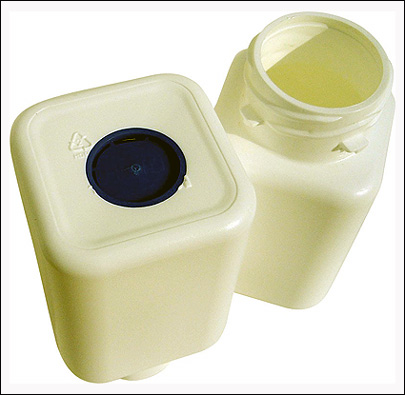RFID tag placement often impacts the success of tag reads, particularly in the case of individual items. When such items are packed too closely together, the transmission of one tag may interfere with that of another. Inconsistent positioning on packages can also impede reads.
The health-care packaging division of Owens-Illinois (O-I) has unveiled a plastic pharmaceuticals bottle with an RFID inlay embedded directly into the base of the container. This, it says, will address these problems for drug providers looking to tag individual bottles.

The $7.1-billion-a-year company is headquartered in Perrysburg, Ohio. Its health-care packaging division has been working on the RFID bottle since January, and now has a final version of the product ready for trial. The RFID inlay is situated in a cavity centered in the bottom of the bottle, covered by a plastic disk that protects the embedded tag from incidental damage that could render it inoperable. “RFID inlays are fragile and can easily be damaged or broken,” says Brian Chisholm, development engineer with the company’s health-care packaging division. “When embedded in the base, it’s protected.” The disk also provides security—were someone to remove the disk, that person would not be able to pop it back into place, and thus could not swap the bottle’s inlay.
The company claims the embedded tags ensure more consistent read rates. “Because the inlays are always in the middle of the bottle, they are always evenly spaced apart, so you get better readability,” Chisholm explains. “And because they are always on the bottom, the antenna is always oriented the same way.”
The RFID bottles’ high read rates were showcased last week at the RFID Health-Care Industry Adoption Summit conference in Washington, D.C. O-I partnered with Impinj for the demonstration, which was conducted using Impinj’s Speedway reader and O-I bottles containing Impinj’s flagship UHF Gen 2 chip, Monza. Both the reader and chip carry EPCglobal‘s certification marks for Gen 2 compliance and Gen 2 interoperability.
In one demonstration simulating movement along a typical circular conveyer used at pharmaceutical companies, the system programmed 96-bit EPC numbers on tags embedded tags in O-I’s bottles at rates exceeding 600 tags per minute. The bottles contained liquids, gel caps, solids and powder doses. After the programming concluded, the interrogator read the tags.
A second demonstration featured the Impinj reader interrogating a Monza UHF Gen 2 tag affixed to a case, as well as all 48 tagged bottles packed within the case. In both demonstrations, read rates were at 100 percent.
O-I can embed UHF or HF inlays, depending on the customer’s requirements. In addition, the company can add security features to the disk and inlay, including chemical tracers and microfibers designed to provide added markings to identify a company’s bottle. These security features can either be hidden or clearly visible to the naked eye, depending on the client’s requirements. They can also require special equipment to be seen.
The company plans to partner with select customers to evaluate the performance of its RFID bottles through the entire supply chain. In addition, it will continue to run performance tests measuring environmental and transportation effects, as well as the potential impact of various sterilization methods on container and tag performance. O-I declined, however, to indicate its timetable for moving its products into production.

